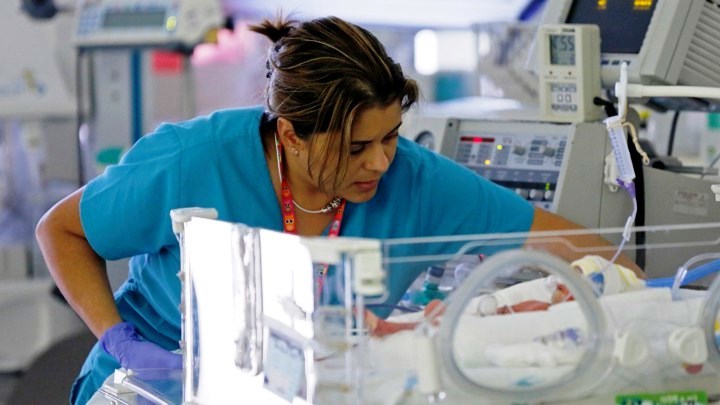




-
2,829 Views 0 Comments 0 Likes

To make health care provision to outpatients and inpatients better, it calls for innovation and creativity to solve the pressing problems affecting the patients. This will in the end help to make nurses’ work a pleasant experience. The essay presents an innovative adoption of Information Technology in using leadless and wireless bedside telemetry monitoring. The telemetry monitoring accords mobility to the patient and provides the nurses with an efficient and effective way to look after the patients.
The demand for improving patient mobility has skyrocketed over the years, pressing the need for telemetry. Today, caregivers have to move patients repeatedly in the health facility (Matano & Grabowiski, 2011). I work in a setting where patients are allowed to ambulate the second day after surgery. This causes patients to suffer a multiplicity of problems and complications. Obviously, it hurts patients when the nursing staff takes them off the leads. It can even cause their skin to tear, especially the elderly patients. Staff and visitors in the facility as well as patients have found themselves tripping over the wires, causing them injury or damaging elementary equipment, and due to the fragility of the equipment, it is very expensive to repair them.
It is worth noting that many patients have been complaining of getting little or no night’s sleep due to the leads and wires, which make them uncomfortable. Patients cannot move freely in bed. Patients, of course, have many human needs but cannot freely ambulate from point to point in the health facility, e.g. going freely to the washroom. Nurses therefore have a great deal of work cut out for them, they have to constantly and repeatedly stop patient record keeping and administering medication to having to detach and reattach the leads repeatedly. They have to do that because lead falls off frequently and the patients’ ambulation in the unit is necessary. Many of the failures in telemetry are traceable to lead and electrode problems. Actually, most of the failures are due to lead because of its heaviness. Many people lose their transmitters. Some damage it by exposing the lead to water, or fluids (Search health IT, 2012).
As Schulz (2010) in part III of Being Wrong puts across, we should change our beliefs over time so that we avoid being wrong. This calls for a change of belief for the use of the lead telemetry equipment with cables. There is no problem if a new belief sets in, such that the previous belief declares the previous invalid. With the dawn of something new and better, the old school of thought should be replaced with the new one. The new idea is the use of wireless and leadless telemetry. In the chapter How Wrong? Shulz clearly writes against the justification of people’s wrongs. She explains that the defense is always there to make you sound right and visionary. Procrastination is also an enemy of correcting your wrongs since an individual obtains satisfaction that he/she has been wrong that time only. At times, people may start blaming others, and anyone else except for themselves. The line between explaining one’s mistake and justifying them is very thin.
In the chapter on acceptance and denial, Schulz (2010) warns against denial. The chapter explains denial as the refusal to accept what is the truth, because the truth is unwelcome. It is a mystery for the mind to lie on its own. Therefore, both patients and the nursing staff should find it in their minds to accept the shortcomings associated with the lead and cable telemetry equipment. This can also be looked from another angle of whether the proposal on wireless and leadless telemetry could be wrong. If the idea turns out to be wrong, denying the error will look irrational, ugly and irresponsible, while admitting it is a show of courage, grace and honor (Schulz, 2010).
The use of wireless and leadless bedside on telemetry units easily addresses the problems mentioned in this paper. Taking up the opportunity will make health care organizations save money and resources while improving care giving. This technology gets rid of the need for wired cable connections. This increases the mobility of both the patients and the nursing staff thereby improving treatment results. They transmit wireless patient electrocardiograms thereby delivering patient information in the cardiac area (Matano & Grabowiski, 2011). There is a central monitor at the nurses’ station. This enables nurses to communicate with the patient via a Bluetooth device if they need to as they ambulate in the unit. For example, if a nurse wants to inform the patient that the medicine is due, he/she can just do that via Bluetooth. When the patient is working with physical therapy, wireless communication will be used to communicate the problem.
In the University of Nottingham, a wireless cardiograph through RF telemetry was used to track the fetus’ progress during labor. The use of wireless terminals was employed to extract medical data during ward visits. The health care giver does not have to be in hospital to see the undertaking; he can access them remotely. This makes the doctor’s job interesting and flexible by increasing mobility. This is enabled by broadband networks, which allow fast Internet over a large area. Since wireless technology has become affordable these days, with wireless laptops, CD-ROM problem diagnostic and resolution available, the application of wireless technology in the changing health sector will increase profitability, efficiency, and service delivery (Ibokwe, 2007).
Certainly, resources for the initial installation of systems have to be incurred. It involves the use of portable computer applications, which must be purchased. It also involves the use of radio and infrared technology rather than using physical cables to link components. This technology is expensive. However, there exist many inexpensive computer applications in the market today. Most health care centers and organizations have been rather slow in uptaking wireless technology on the ground of their initial cost and the cost of maintenance but not anymore due to the current wide availability of computers and wireless technology at a cheaper price.
The nursing practice evidently shows a number of problems discussed in this paper. The lead telemetry equipment hurts patients and tears the skins of the elderly. The cables cause patients to clutter, and visitors, patients and staff trip over the cables risking injury and damage of the equipments whose repair is expensive. The leads make the patients uncomfortable so that they lack sleep at night. Doctors, nursing staff and patients cannot move freely. Since the leads drop frequently, the nurses have to leave their record keeping tasks to attach and reattach the lead. The quick solution to these problems is the adoption of the leadless and wireless bedside monitoring telemetry units. There is still a central monitor at the nurses’ station. Nurses can communicate with the patients via wireless means like Bluetooth and broadband. This, in the end, will reduce costs, improve the stuff’s working environment and service delivery. Therefore, the innovation of using the wireless telemetry will improve the nursing environment, which will become more pleasant for both the nurses and patients. Hence, all the health institutions should adopt this innovation and avoid being wrong in their judgment.
References
Ibokwe, O. (2007). Wireless technology and health care. Bioheathmatics , 16-22.
Matano, T., & Grabowiski, M. (2011). Medical telementry grows with changing nature of health care. Biomedical instrumentation and Technology , 186-189.
Schulz, K. (2010). Being Wrong: Adventures in the margin of error. HarperCollins
Search health IT. (2012). What is wireless medical telementry services. Wireless medical telementry services , 20-24.



